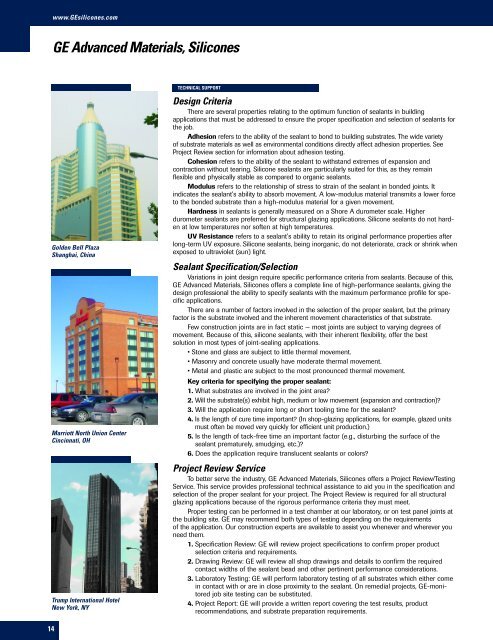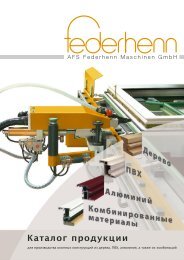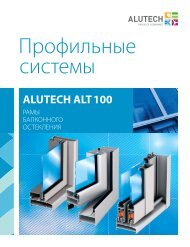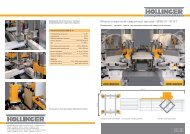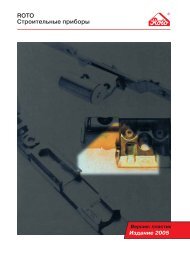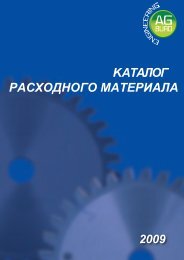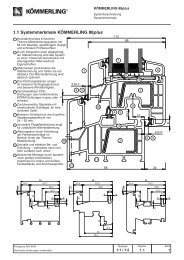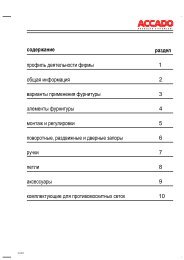Construction Products
Construction Products
Construction Products
- No tags were found...
You also want an ePaper? Increase the reach of your titles
YUMPU automatically turns print PDFs into web optimized ePapers that Google loves.
www.GEsilicones.comGE Advanced Materials, SiliconesGolden Bell PlazaShanghai, ChinaMarriott North Union CenterCincinnati, OHTrump International HotelNew York, NYTECHNICAL SUPPORTDesign CriteriaThere are several properties relating to the optimum function of sealants in buildingapplications that must be addressed to ensure the proper specification and selection of sealants forthe job.Adhesion refers to the ability of the sealant to bond to building substrates. The wide varietyof substrate materials as well as environmental conditions directly affect adhesion properties. SeeProject Review section for information about adhesion testing.Cohesion refers to the ability of the sealant to withstand extremes of expansion andcontraction without tearing. Silicone sealants are particularly suited for this, as they remainflexible and physically stable as compared to organic sealants.Modulus refers to the relationship of stress to strain of the sealant in bonded joints. Itindicates the sealant’s ability to absorb movement. A low-modulus material transmits a lower forceto the bonded substrate than a high-modulus material for a given movement.Hardness in sealants is generally measured on a Shore A durometer scale. Higherdurometer sealants are preferred for structural glazing applications. Silicone sealants do not hardenat low temperatures nor soften at high temperatures.UV Resistance refers to a sealant’s ability to retain its original performance properties afterlong-term UV exposure. Silicone sealants, being inorganic, do not deteriorate, crack or shrink whenexposed to ultraviolet (sun) light.Sealant Specification/SelectionVariations in joint design require specific performance criteria from sealants. Because of this,GE Advanced Materials, Silicones offers a complete line of high-performance sealants, giving thedesign professional the ability to specify sealants with the maximum performance profile for specificapplications.There are a number of factors involved in the selection of the proper sealant, but the primaryfactor is the substrate involved and the inherent movement characteristics of that substrate.Few construction joints are in fact static — most joints are subject to varying degrees ofmovement. Because of this, silicone sealants, with their inherent flexibility, offer the bestsolution in most types of joint-sealing applications.• Stone and glass are subject to little thermal movement.• Masonry and concrete usually have moderate thermal movement.• Metal and plastic are subject to the most pronounced thermal movement.Key criteria for specifying the proper sealant:1. What substrates are involved in the joint area?2. Will the substrate(s) exhibit high, medium or low movement (expansion and contraction)?3. Will the application require long or short tooling time for the sealant?4. Is the length of cure time important? (In shop-glazing applications, for example, glazed unitsmust often be moved very quickly for efficient unit production.)5. Is the length of tack-free time an important factor (e.g., disturbing the surface of thesealant prematurely, smudging, etc.)?6. Does the application require translucent sealants or colors?Project Review ServiceTo better serve the industry, GE Advanced Materials, Silicones offers a Project Review/TestingService. This service provides professional technical assistance to aid you in the specification andselection of the proper sealant for your project. The Project Review is required for all structuralglazing applications because of the rigorous performance criteria they must meet.Proper testing can be performed in a test chamber at our laboratory, or on test panel joints atthe building site. GE may recommend both types of testing depending on the requirementsof the application. Our construction experts are available to assist you whenever and wherever youneed them.1. Specification Review: GE will review project specifications to confirm proper productselection criteria and requirements.2. Drawing Review: GE will review all shop drawings and details to confirm the requiredcontact widths of the sealant bead and other pertinent performance considerations.3. Laboratory Testing: GE will perform laboratory testing of all substrates which either comein contact with or are in close proximity to the sealant. On remedial projects, GE-monitoredjob site testing can be substituted.4. Project Report: GE will provide a written report covering the test results, productrecommendations, and substrate preparation requirements.14


